
Myrmicinae is a subfamily of ants, with about 140 extant genera; their distribution is cosmopolitan. The pupae lack cocoons. Some species retain a functional sting. The petioles of Myrmicinae consist of two nodes. The nests are permanent and in soil, rotting wood, under stones, or in trees.

Dolichoderinae is a subfamily of ants, which includes species such as the Argentine ant, the erratic ant, the odorous house ant, and the cone ant. The subfamily presents a great diversity of species throughout the world, distributed in different biogeographic realms, from the Palearctic, Nearctic, Afrotropical region and Malaysia, to the Middle East, Australian, and Neotropical regions.

Megalomyrmex is a genus of ant in the subfamily Myrmicinae. The genus is known only from the Neotropics, where some of the species are specialized parasites or predators of Attini.

Crematogastrini is a tribe of myrmicine ants with 64 genera and 8 fossil genera.

Myopopone is a genus of ants in the subfamily Amblyoponinae. The genus contains two species, one extant and one fossil. The type species Myopopone castanea is known from the Oriental and Indo-Australian regions, and China. The fossil species, Myopopone sinensis, is known from the Early Miocene.
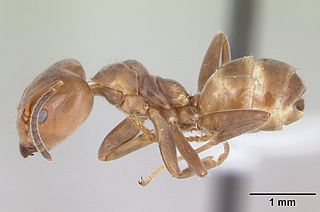
Azteca is a strictly Neotropical genus of ants in the subfamily Dolichoderinae. The genus is very diverse and contains around 84 extant species and two fossil species. They are essentially arboreal and many species have mutualistic associations with particular plant species, where the genus Cecropia presents the most conspicuous association. In the Brazilian Amazonia, Azteca species are associated with species of Codonanthopsis.
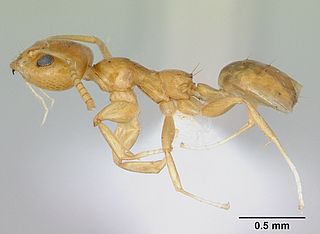
Axinidris is a genus of arboreal ants in the subfamily Dolichoderinae. The genus is known from forested areas the Afrotropics, where they nest in hollow stems or rotten wood. They forage mainly in trees, but occasionally on the ground.
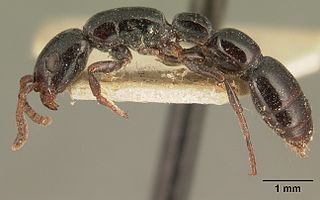
Simopone is a genus of predominantly arboreal ants in the subfamily Dorylinae. The genus is widely distributed in the Old World tropics, with the majority of species in Madagascar and sub-Saharan Africa.

Daceton is a Neotropical genus of ants in the subfamily Myrmicinae. The genus contains only two species: D. armigerum, the most studied species, distributed throughout northern South America, and D. boltoni, known from Brazil and Peru.
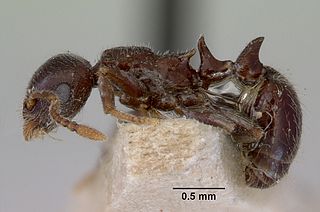
Peronomyrmex is a rare genus of ants in the subfamily Myrmicinae. Its three species are known from the east coast of Australia. With only five specimens in total, collected from four localities, Peronomyrmex is one of the world's most rare ant genera.
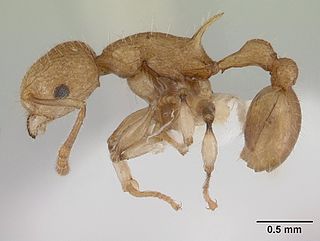
Vombisidris is a genus of subarboreal and arboreal ants in the subfamily Myrmicinae. Its species are known from India to Queensland, Australia. Like most other arboreal ants, their biology remains unknown.

Terataner is an African genus of arboreal ants in the subfamily Myrmicinae.

Tetheamyrma is a genus of ants in the subfamily Myrmicinae containing the single species Tetheamyrma subspongia. The genus is known only from two workers collected in a leaf litter sample in eastern Malaysia.

Ankylomyrma is a genus of large arboreal ants in the subfamily Agroecomyrmecinae. It contains the single species Ankylomyrma coronacantha, the sole member of the tribe Ankylomyrmini. The genus is known from Africa. Nothing is known about their biology. The genus was moved from the subfamily Myrmicinae to Agroecomyrmecinae in 2014.
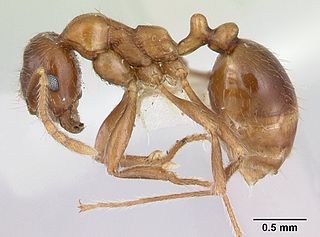
Kartidris is an Indomalayan genus of terrestrial ants in the subfamily Myrmicinae. Its six species are known from mountainous areas in China, Thailand and India.

Paratopula is a genus of ants in the subfamily Myrmicinae. The genus consists of arboreal species known from the Oriental and Indo-Australian regions. Little is known about their biology.
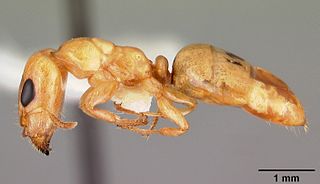
Gesomyrmex is a genus of ants in the subfamily Formicinae. The genus contains six extant species, known from the Indomalayan realm, and nine fossil species. Of the extant species, four are known only from workers and two only from females. The extinct species "G. expectans" and "Gesomyrmex miegi", formerly placed in the genus, were excluded by Dlussky et al.., 2009.

Cladomyrma is a genus of ants in the subfamily Formicinae. The genus is restricted to the Malay Peninsula, Borneo, and Sumatra. All known Cladomyrma species build their nests on live stems.

Aptinoma is a small genus of arboreal ants in the subfamily Dolichoderinae. Its two species are known only from Antongil Bay, Madagascar.



















